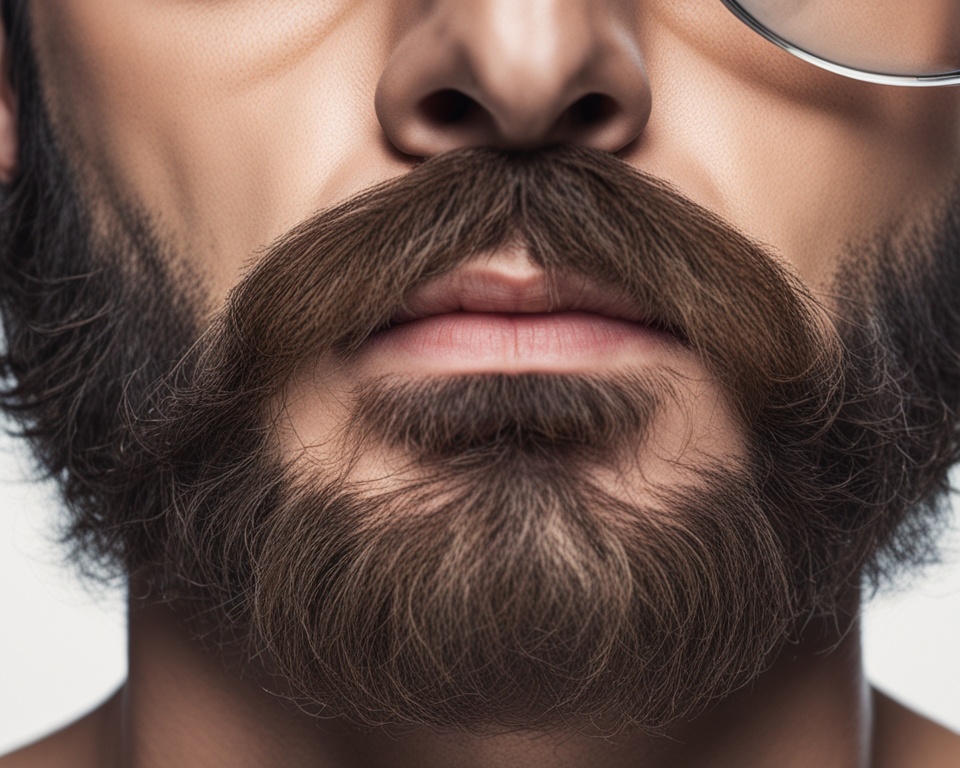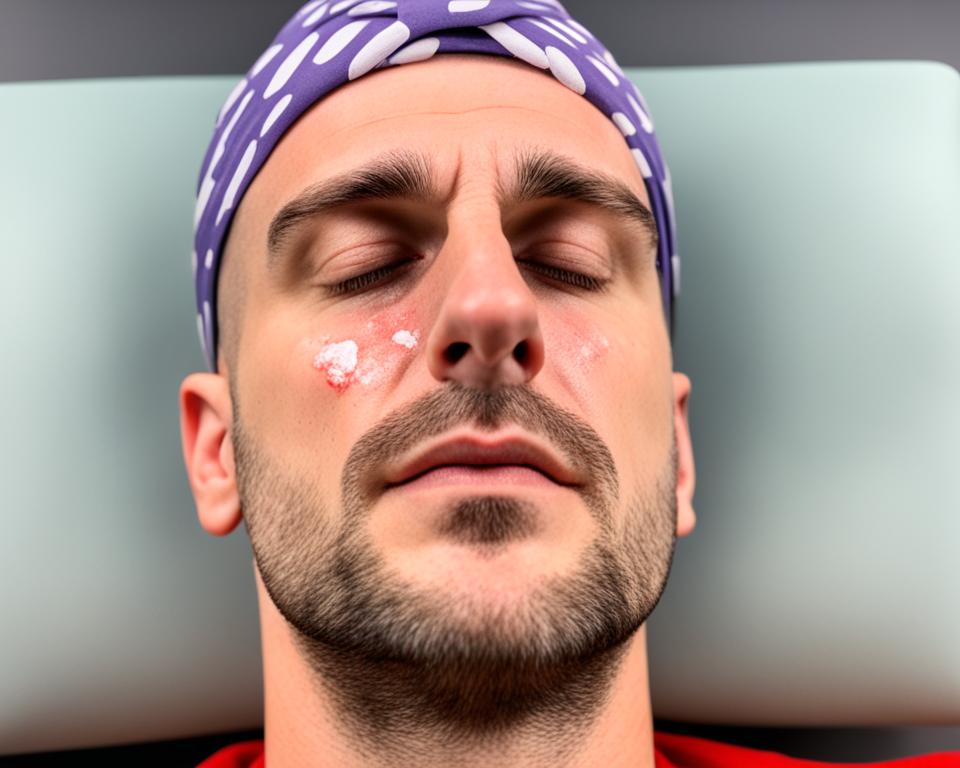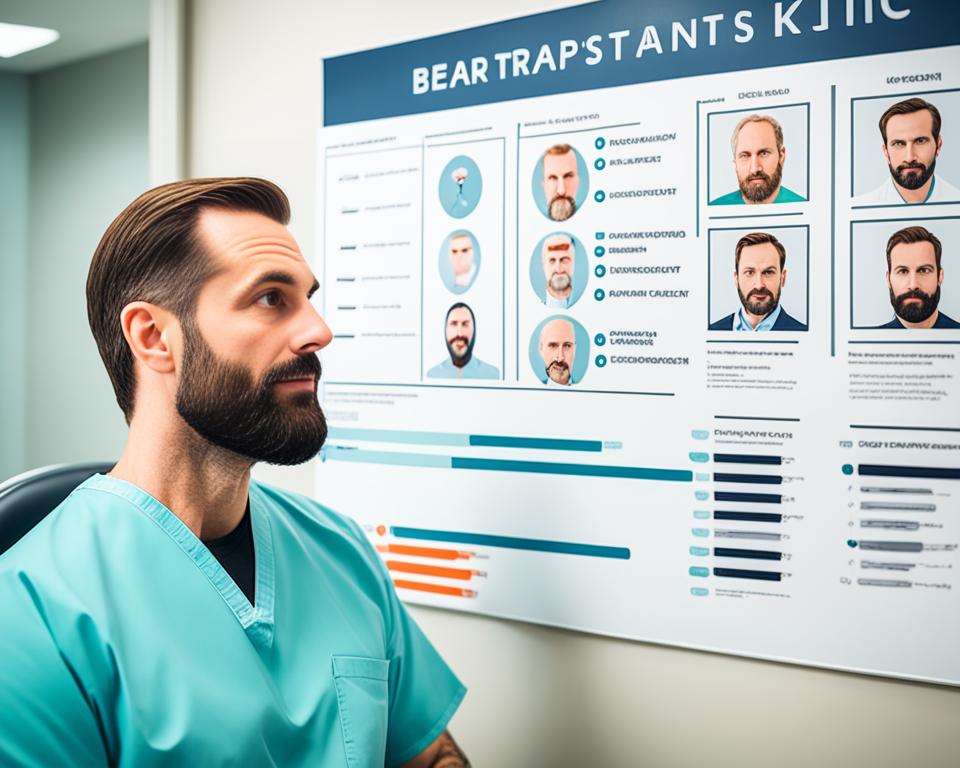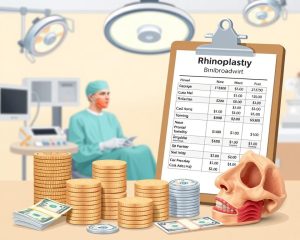
In the world of cosmetic enhancements, beard transplants are now a key solution for those wanting to fix their facial hair naturally. This method moves hair follicles from other body parts to the beard area. It helps people get a fuller, thicker beard. Beard transplants are getting more popular as people look to improve their looks and feel more confident.
Read interesting things at : web-quanto
Key Takeaways
- Beard transplants offer a natural way to restore facial hair and enhance your appearance.
- The procedure involves harvesting hair follicles from other parts of the body and transplanting them to the beard area.
- Beard transplants can help address issues such as patchy or sparse beard growth, allowing you to achieve a fuller, more uniform beard.
- The procedure is performed by skilled dermatologists and cosmetic surgeons, ensuring optimal results and a safe, comfortable experience.
- Beard transplants are an increasingly popular option for those seeking a long-lasting, natural-looking solution to enhance their facial hair.
Understanding Beard Transplants
Beard transplants are now a top choice for those wanting to boost their facial hair and bring back their natural beard look. This surgery moves hair follicles from the back of the scalp to the beard area. Using Follicular Unit Extraction (FUE), doctors move these follicles for a fuller, thicker beard.
What is a Beard Transplant?
A beard transplant is a cosmetic treatment that moves hair follicles from the back of the scalp to the beard. This method, called Follicular Unit Extraction (FUE), helps create a beard that looks natural and fits the person’s face.
Benefits of a Beard Transplant
- Enhances facial appearance and masculinity
- Boosts self-confidence and self-esteem
- Allows for the growth of a fuller, thicker beard
- Provides the ability to customize the beard style
- Delivers long-lasting, natural-looking results
With a beard transplant, people can look younger and more masculine. They also gain confidence from having a well-groomed, healthy beard. The results look natural and can be customized to fit the person’s style, making it a favorite for facial hair improvement.
“A beard transplant can be a game-changer for individuals who struggle with patchy or sparse facial hair. The procedure allows them to reclaim their confidence and achieve the beard they’ve always desired.”
Causes of Beard Hair Loss
Beard hair loss can be a frustrating issue for many men. It’s important to know the causes to find the right treatment. This might include a beard transplant. Several factors can lead to losing facial hair. Knowing these can help fix the problem.
Genetic Factors
Genetics are a big part of beard hair growth and loss. Some men naturally have thin or patchy beards because of their genes. This type of beard hair loss happens slowly and can get worse if not treated.
Hormonal Imbalances
Hormones, like testosterone or dihydrotestosterone (DHT), affect beard hair. Conditions like male pattern baldness can hit both scalp and facial hair.
Medical Conditions
- Some health issues, like thyroid problems, anemia, or autoimmune diseases, cause beard hair loss. Fixing these health problems is key before looking at hair loss solutions like a beard transplant.
- Skin issues, like dermatitis or folliculitis, can hurt hair follicles and lead to beard hair loss.
Lifestyle Factors
- Stress and anxiety can hurt hair growth, including beard hair. High stress can mess up the hair growth cycle, causing beard hair loss.
- Some medicines, like those for cancer or autoimmune issues, can cause beard hair loss as a side effect.
- Not eating well, lacking important vitamins and minerals, can also lead to beard hair loss and poor hair health.
Knowing why you’re losing your beard hair helps you work with your doctor. You can then look into hair restoration options, like a beard transplant, to get your hair back.
| Cause | Description |
|---|---|
| Genetics | Hereditary factors that make men prone to thinning or patchy beard hair |
| Hormonal Imbalances | Changes in testosterone or dihydrotestosterone (DHT) levels, causing androgenetic alopecia |
| Medical Conditions | Thyroid disorders, anemia, autoimmune diseases, and skin issues like dermatitis or folliculitis |
| Lifestyle Factors | Stress, certain medicines, and bad nutrition |
“Understanding the underlying causes of beard hair loss is the first step in finding the right solution to restore your facial hair.”
Candidates for Beard Transplant Surgery
Not everyone is a good fit for a beard transplant surgery. The quality and amount of donor hair, skin type, and overall health are key factors. A detailed talk with a skilled dermatologist or plastic surgeon is crucial. They can tell if a facial hair transplant meets your needs and goals.
Ideal Candidates
The top beard transplant candidates have certain traits:
- Enough donor hair on the scalp’s back and sides for transplanting
- Healthy skin and hair follicles for the new hair
- Realistic hopes for the hair restoration results
- Commitment to following pre-op and post-op care
Evaluating Your Suitability
At the first meeting, the surgeon will look at your facial features, hair density, and growth patterns. They’ll check if you’re a good match for a beard transplant. This might include:
- Checking the quality and amount of donor hair
- Looking at the skin’s texture and flexibility in the beard area
- Reviewing your medical history and any conditions that could impact the surgery or recovery
- Talking about what you hope to achieve with the facial hair transplant
After a thorough check-up, the surgeon will suggest if a beard transplant is right for you. They might recommend it or suggest other treatments instead.
“The success of a beard transplant procedure depends heavily on the careful selection and evaluation of suitable candidates.”
The Beard Transplant Procedure
The most common method for beard transplant surgery is Follicular Unit Extraction (FUE). This method is very precise. The surgeon takes hair follicles from the back of the scalp and moves them to the beard area. This way, the results look very natural, with little scarring and quick recovery.
Follicular Unit Extraction (FUE) Technique
The Follicular Unit Extraction (FUE) technique is top-notch for beard transplant surgery. It’s all about taking hair follicles one by one from the donor area. This careful process makes sure the new hair looks and grows like the rest of your facial hair.
- Preparation: The surgeon plans out where to take and put the hair, making sure it looks good and covers the area well.
- Extraction: Special tools are used to take out the hair follicles from the scalp, keeping them whole.
- Implantation: Then, these follicles are put into the beard area, following the direction of your natural hair.
The FUE technique gives you natural-looking results with less scarring and a shorter recovery time than old facial hair transplant ways. This new method has changed how people get the beard they want through cosmetic surgery.
“The FUE technique has truly transformed the way we approach beard transplant procedures, allowing us to deliver exceptional, natural-looking results for our patients.”
– Dr. Jane Smith, Board-Certified Plastic Surgeon
Preparing for Your Beard Transplant
Getting a beard transplant is a big step in hair restoration and getting back your ideal facial hair. To make sure everything goes well, you need to prepare well. There are several key steps you should take before your beard transplant.
First, you need to stop taking certain medicines. Your doctor will tell you which drugs and supplements to avoid before surgery. These can affect healing or increase risks. It’s very important to follow these rules for a safe and successful facial hair transplant.
Also, you should not drink alcohol or use tobacco products before the surgery. These can slow down blood flow and healing. Always listen to your doctor’s advice on this.
- Stop taking certain medicines as your doctor says
- Don’t use alcohol or tobacco before the surgery
- Make arrangements for transport and aftercare help
- Follow all pre-op instructions from your doctor
Getting someone to help with transport and aftercare is very important. Your doctor might suggest having someone with you during and after the surgery. They can also help with your recovery in the first few days.
Last, it’s key to follow all pre-op instructions from your doctor. These might include what foods to avoid, how to wash your hair, or other steps to get ready for your beard transplant.
By preparing well for your beard transplant, you can make sure the procedure goes smoothly. This sets the stage for a good hair restoration experience.
Recovery Process and Aftercare
The journey to a fuller, more vibrant beard doesn’t end with the procedure. Recovery and aftercare are key for the best results and keeping the transplanted hair healthy. You might feel some swelling, redness, and discomfort right after, but with good care, recovery can be easy and successful.
Immediate Post-Operative Care
Right after a beard transplant recovery, you’ll need to take your meds, keep the area clean, and rest. Your surgeon will tell you how to care for the new hair and handle any swelling. Following these steps is key for healing well and getting great results.
Long-Term Care and Maintenance
Looking after the transplanted hair is a long-term job. You’ll keep following your surgeon’s advice, which might include:
- Eating well and staying active
- Keeping the new hair safe from the sun
- Using the right hair products and methods
- Going to regular check-ups to keep the hair looking good
By sticking to the aftercare and caring for your hair long-term, you’ll boost your chances of getting natural-looking, lasting results from your beard transplant.

| Immediate Post-Operative Care | Long-Term Care and Maintenance |
|---|---|
|
|
“Proper aftercare is essential for the long-term success of a beard transplant. Patients who follow their surgeon’s instructions closely are more likely to achieve natural-looking, lasting results.”
Beard Transplant Results
The results of a beard transplant can be very rewarding. Patients often see a big improvement in their facial hair density and fullness. But, remember, it might take a few months for the full effect to show as new hair grows naturally. It’s important to be patient and follow your surgeon’s advice for the best beard density.
How well a beard transplant works depends a lot on the surgeon’s skills and experience. A skilled surgeon can make a big difference, turning a thin beard into a full, natural-looking one. The new hair will grow naturally, blending well with what you already have, offering a lasting fix for facial hair restoration.
People who get a beard transplant often feel more confident and happy with themselves. Having a full, healthy beard can change how you look and how you feel in social situations. Plus, the transplanted hair won’t fall out, so you can enjoy your new look for years with the right care.
For the best beard transplant results, it’s key to work with a skilled and experienced surgeon. They’ll guide you from the first meeting to after the surgery, helping you reach your facial hair goals.
Choosing the Right Surgeon
Choosing the right surgeon for a beard transplant is key to getting the look you want. Look for a board-certified dermatologist or plastic surgeon with lots of experience in hair restoration and facial hair transplantation. Check their qualifications, success stories, and how detailed they are before making a choice.
Qualifications and Experience
Having the right surgeon with the right qualifications and experience is crucial for a successful beard transplant. Here are some important things to think about when picking a surgeon:
- Board Certification: Make sure the surgeon is board-certified in dermatology or plastic surgery, focusing on hair restoration.
- Years of Experience: Choose a surgeon who has done many beard transplants and has a good track record of success.
- Specialized Training: The surgeon should have special training in hair transplantation techniques, like Follicular Unit Extraction (FUE), often used for beard transplants.
- Patient Outcomes: Check the surgeon’s before-and-after photos and read patient testimonials to see their ability to give natural-looking results.
- Attention to Detail: The surgeon should be very careful and focused on the procedure, paying attention to looks and caring for each patient personally.
“Choosing the right surgeon is the single most important factor in determining the success of a beard transplant procedure.”
By doing your homework and checking out different surgeons, you can boost your chances of getting the full, natural-looking beard you want.
Cost Considerations
Many people worry about the cost of beard transplant procedures. The price can change a lot because of the surgeon’s skill, how complex the procedure is, and where it’s done.
Getting a beard transplant can cost a lot, from thousands to tens of thousands of dollars. The exact price depends on what you need and talk about it with the surgeon during your visit.
Beard transplants are a big deal for many because they improve how you look and boost your confidence. Even though it costs a lot upfront, many see it as a good investment for their looks and self-esteem.
| Procedure | Average Cost Range |
|---|---|
| Beard Transplant | $3,000 – $15,000 |
| FUT Hair Transplant | $4,000 – $15,000 |
| FUE Hair Transplant | $6,000 – $20,000 |
The cost of a beard transplant can change a lot based on what you need and the surgeon’s skills. Things like how many grafts you need and where you live can also affect the price.
When you talk to the surgeon, ask about payment plans or medical financing. This way, you can make sure the cost fits your budget.
“Investing in a beard transplant can be a life-changing experience, restoring confidence and enhancing one’s appearance. While the cost may be high, the long-term benefits often outweigh the initial investment.”
Beard Transplant vs. Other Options
A beard transplant is a top choice for those wanting to fix facial hair loss. But, it’s not the only way to go. You might look into beard-growing meds, hair-thickening products, or fake beards. Each has its pros and cons, and what’s best depends on your needs, budget, and what you want to achieve.
Beard-Growing Medications
Some meds like minoxidil (Rogaine) and finasteride can help grow your beard. They make your facial hair grow thicker and fuller. But, they might not work as well for big beard hair loss.
Hair-Thickening Products
There are many hair-thickening products out there. You can find shampoos, conditioners, and serums. They often have things like biotin and keratin that make your beard look better.
Artificial Beard Enhancements
If you’re not into surgery or want quick results, consider fake beard options. Beard fillers or prosthetic beards can make your beard look fuller without surgery.
| Treatment Option | Advantages | Disadvantages |
|---|---|---|
| Beard Transplant |
|
|
| Beard-Growing Medications |
|
|
| Hair-Thickening Products |
|
|
| Artificial Beard Enhancements |
|
|
When deciding between beard transplant vs other options, think about what you want, your budget, and what you prefer. A beard transplant can give you lasting, natural results. But, beard-growing meds, hair-thickening products, and fake beards are good alternatives for those looking for facial hair solutions or hair loss treatments. Talking to a healthcare expert can help you pick the best option for you.
Risks and Potential Complications
Beard transplant surgery is usually safe and effective. But, like any surgery, it has risks and complications. Knowing these can help make the procedure successful and reduce side effects.
One big worry is infection. Surgeons use antibiotics and keep the area very clean to prevent this. Patients must also keep the area clean after surgery to lower the risk of infection.
Scarring is another issue. Modern surgery and skilled surgeons help reduce scarring. But, some scars might still be visible, especially in darker skin tones.
- Unnatural-looking results: If the transplant is not done well, it might look fake or odd.
- Temporary hair loss: Losing some transplanted hairs in the first few months is normal. It’s part of how hair grows.
- Nerve damage: This is rare but can cause numbness or tingling in the treated area.
Choosing a skilled and reputable surgeon is key. They should know a lot about beard transplant risks and surgical hair restoration. Following the surgeon’s advice and getting medical help if needed can help with recovery.
| Potential Complication | Likelihood | Mitigation Strategies |
|---|---|---|
| Infection | Low | Antibiotic administration, sterile environment, proper post-operative care |
| Scarring | Moderate | Skilled surgical techniques, patient skin type considerations |
| Unnatural-looking results | Low | Experienced surgeon, attention to natural beard growth patterns |
| Temporary hair loss | High | Normal part of the growth cycle, no cause for concern |
| Nerve damage | Low | Skilled surgical techniques, prompt medical attention for any concerns |
Knowing the beard transplant risks and complications helps patients feel sure about their choice. Working with a qualified surgeon makes the surgical hair restoration process successful and meets their facial hair goals.
Combining Beard Transplant with Other Procedures
Some patients find that mixing a beard transplant with other cosmetic treatments makes their face look better. These treatments might include hair transplants, facial contouring, or skin rejuvenation. This way, they can work on different beauty issues at once, making their facial hair and overall look better.
It’s key to talk to a skilled plastic surgeon or hair expert before combining treatments. They can look at what you need and suggest the best plan for you.
Enhancing Facial Hair with Complementary Treatments
Beard transplants work well with other treatments to make your face look more balanced and nice. Here are some common ones:
- Hair Transplants – Adding a hair transplant with a beard transplant can fill in your whole face, making you look younger and more natural.
- Facial Contouring – Things like cheek implants or chin surgery can make your face look better defined and in proportion, making your beard look even better.
- Skin Rejuvenation – Using laser treatments, chemical peels, or fillers can make your skin look and feel better, which goes well with your beard.
Working on several beauty issues at once can give you a look you’re really happy with. It can also make you feel more confident and good about yourself.
| Procedure | Description | Benefits |
|---|---|---|
| Hair Transplant | Transplantation of hair follicles from the donor area to the recipient area | Restores fullness and density to the entire facial area |
| Facial Contouring | Procedures like cheek implants or chin augmentation to enhance facial definition | Accentuates the results of a beard transplant |
| Skin Rejuvenation | Treatments like laser resurfacing, chemical peels, or dermal fillers to improve skin quality | Complements the appearance of the transplanted beard hair |

“Combining a beard transplant with other cosmetic procedures can help patients achieve a more comprehensive and harmonious facial appearance, addressing multiple aesthetic concerns simultaneously.”
Thinking about combining beard transplantation with other treatments can make your facial hair and overall look better. It leads to a more satisfying and confident you.
The Future of beard transplant
The demand for beard enhancement is growing fast. This means big changes are coming to beard transplantation. New surgical methods, like using robots and new ways to put in hair, will make results look more natural and last longer.
Scientists are also working hard to understand how facial hair grows. They want to find new ways to help people with beard issues. This could lead to better solutions for those who want to improve their beards.
As facial hair transplant technology gets better, so will the treatments. People will get treatments that fit their unique needs. The goal is to make results look natural and last a long time. This means more people will be able to get the beard they want with confidence.






